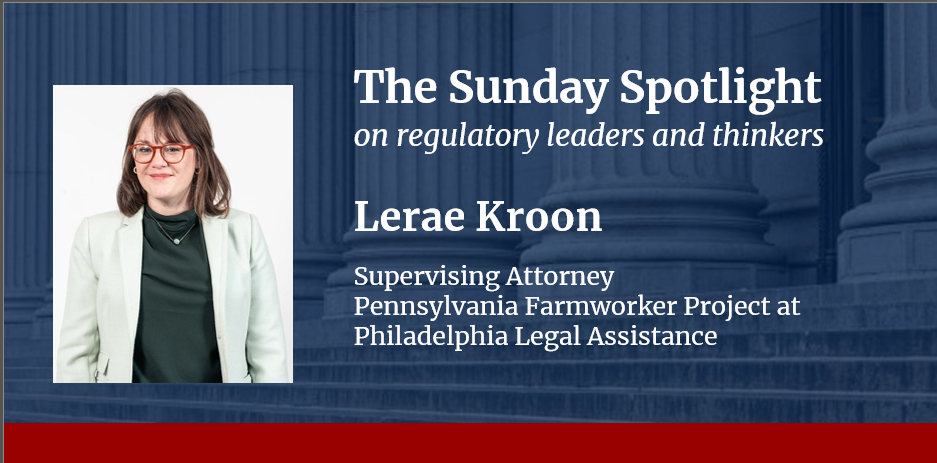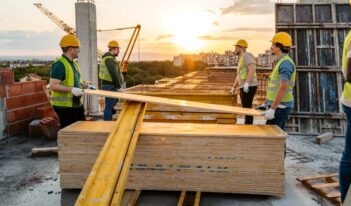
Lerae Kroon explains how direct legal services providers interact with regulations protecting farmworkers.
In a conversation with The Regulatory Review, Lerae Kroon, supervising attorney of the Pennsylvania Farmworker Project at Philadelphia Legal Assistance, discusses how non-profit organizations participate in the regulatory process and how she interacts with government agencies to support farmworkers in accessing justice.
The H-2A program enables some domestic employers to bring foreign nationals to the United States to work in temporary agricultural positions. In December 2024, the U.S. Citizenship and Immigration Service revised the program to strengthen worker protections for agricultural workers.
President Donald Trump has prioritized immigration as a policy issue in each of his presidential campaigns. Since his inauguration in January, he has issued multiple executive orders to decrease immigration and increase deportations. Reportedly, in light of these executive actions, farmworkers are fearful that they could face deportation or other legal consequences.
Lerae Kroon emphasizes the importance of staying up to date with changing regulations in her work with farmworkers. She shares how workers and their employers are impacted by developments in immigration policy. Kroon explains how non-profits working with clients affected by agency regulations can have a mutually beneficial relationship with government actors. Moreover, she discusses the gaps in protections for farmworkers and addresses how legal services providers can help enforce legal protections for farmworkers who may not know their rights.
Kroon has worked as an attorney advocating for tenants, farmworkers, and immigrant laborers throughout her career. Through her work at the Pennsylvania Farmworker Project, she aims to assist farmworkers with legal issues and advocates workplace safety, better health standards, and fairer wages. Kroon graduated from Harvard Law School, where she was recognized for her contributions to clinical work and from which she received a post-graduation fellowship to provide humanitarian immigration legal services.
The Regulatory Review is pleased to share the following interview with Lerae Kroon.
The Regulatory Review: How do non-profits engaged in legal advocacy generally work with government agencies?
Kroon: I currently work at a non-profit focused on providing direct services and representation to low-income individuals and groups who would otherwise struggle to access justice. At times, we represent individual clients before government agencies such as the U.S. Social Security Administration or state offices of unemployment compensation. As a result, non-profit providers of direct legal services become knowledgeable “repeat players” in systems, with the ability to view and identify trends and gaps in protections for their clients.
Some government agencies value the perspective that non-profit legal advocates can bring and seek their input when creating policy, both informally and in formal rulemaking. This provides advocates with an opportunity to weigh in on the effect of regulations on our clients and raise real-life stories to agencies creating policy that will affect our future clients.
Other types of legal non-profits have the ability and resources to engage in more direct policy advocacy with government agencies by taking an active role in pushing for improvements to law and policy.
TRR: How have you interacted with federal or state agencies while working in farmworker advocacy?
Kroon: In addition to the activities I have already noted, I strive to build strong relationships with labor enforcement agencies at the state and federal level. One reason is capacity: Legal services non-profits consistently encounter more people that need assistance accessing justice than they have the resources to serve. I cannot litigate every case—nor is every case well-suited for litigation. When it comes to issues such as wage theft and health and safety conditions, for example, the goals of labor agencies overlap with worker goals, and an agency complaint is a viable route to a resolution.
In the past, I have engaged in very productive partnerships with agencies through “community enforcement” efforts. In these partnerships, I have been able to work closely with agencies such as the U.S. Department of Labor to investigate and resolve labor violations by connecting them with workers who may otherwise be hesitant to come forward. For example, H-2A temporary agricultural visa workers have particular vulnerabilities related to isolation and the connection of their immigration status with their employment. Some of these workers fear the impact that reporting labor abuses may have on their ability to obtain work visas in the future. I am able to provide context and information about agency processes to help make an informed decision about whether to bring a complaint.
TRR: Do political changes, including President Trump’s inauguration and accompanying changes in regulatory priorities, affect your strategy as an advocate for farmworkers?
Kroon: A new administration means a shift in priorities and resource allocation, which will change how advocates interact with federal agencies. Many priorities and positions are already shifting. Part of my job is to stay up-to-date on changing interpretations of the law and legal concepts, so that I can assess cases and advise my clients accordingly. We will be watching closely in the months ahead to understand the shifting legal landscape for farmworkers. If new regulations are issued, we fully expect to weigh in when requested.
During his first term, the Trump Administration, has suggested that it may support an increase in usage of the H-2A temporary agricultural worker program, possibly including its expansion of eligible employment from seasonal work to year-round work. If that were to occur, there would be significant changes to the nature of agricultural work in Pennsylvania and thus to our work as farmworker advocates. For example, there may be an increased need for enforcement of the H-2A program protections for U.S. workers to ensure that they are not displaced by H-2A workers and that wages and conditions for U.S. workers are not negatively affected by H-2A labor.
TRR: Are there gaps in federal and state protections for farmworkers? If so, what are some examples of these gaps?
Kroon: Many federal and state employment and labor laws carve out exceptions for farmworkers from protections such as minimum wage and overtime protections. Passed in 1938 as part of New Deal policies, the Fair Labor Standards Act excluded farmworker and domestic workers. Employers were not required to pay farmworkers the federal minimum wage until 1966, and farmworkers are still excluded from federal overtime requirements. Most states followed the federal government’s path by excluding farmworkers from state employment laws, including those providing for the right to organize or join unions and key health and safety protections.
Studies by the National Center for Farmworker Health report that farmworkers “represent some of the most socially and economically disadvantaged people in the U.S.” The National Agricultural Workers Survey found that, during 2021 and 2022, the mean and median personal annual income of crop workers was between $20,000 and $24,000, and that 21 percent of workers have family incomes below the poverty level.
TRR: U.S. Customs and Immigration Enforcement has been in the news after reports of recent immigration raids in major cities. How are farmworkers, whether authorized to work in the United States or not, and their employers impacted by these developments?
Kroon: Farmworkers have a variety of immigration statuses, commonly including U.S.-born and naturalized citizenship, lawful permanent residence, work visas, and no status. The National Agricultural Workers Survey found that approximately 68 percent of the U.S. agricultural workforce is made up of individuals born outside of the United States.
In my experience interacting with farmworkers over the past few months, many workers actively fear the effect of immigration raids on their families and communities regardless of their work authorization status. It remains to be seen whether there will be an increase in worksite Immigration and Customs Enforcement raids, but many folks are preparing themselves and their families for the worst possible scenarios. Here in Pennsylvania, we are starting to see reports that agricultural employers, which have historically relied on immigrant labor, are struggling to find enough workers. Farmworkers I speak with are assessing how much risk they face simply by showing up each day to work in an industry staffed primarily by immigrant workers.
TRR: In December 2024, U.S. Citizenship and Immigration Services issued a final rule modifying the H-2A visa program to strengthen worker protections. How do governmental and non-governmental actors alert farmworkers of their legal protections?
Kroon: Ideally, H-2A workers should receive information about their rights at various stages of their employment. H-2A program regulations require employers to include certain information in their job offers, including details about wage and hours, housing, and transportation. Employers must also include assurances committing to abide by H-2A program requirements as part of their job offers. As a result, literate workers who are given a copy of their job offer and contract before beginning employment have information about their legal protections. Unfortunately, we know that some recruiters and employers do not share all required information at the time of hire and that some common program violations—such as charging recruitment fees—can take place before workers ever see a contract.
Non-governmental actors have a huge part to play in informing H-2A workers not only of their rights but also how to enforce them. Because many H-2A workers live in isolated areas and have limited ability to access resources outside their labor camp, farmworker advocacy programs do robust in-person outreach to H-2A workers. We check in, provide information about their rights, and offer support if needed. This season, we are adjusting our know-your-rights trainings and materials to incorporate the updated H-2A rule. In a moment of regulations-in-action, I now get to explain the new protections to the workers they cover, empowering them with information about their rights and inviting them to action if employers are not in compliance.



